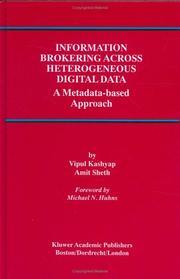| Listing 1 - 8 of 8 |
Sort by
|

ISBN: 1280206128 9786610206124 0306470284 0792378830 Year: 2002 Publisher: New York : Kluwer Academic Publishers,
Abstract | Keywords | Export | Availability | Bookmark
 Loading...
Loading...Choose an application
- Reference Manager
- EndNote
- RefWorks (Direct export to RefWorks)
Information intermediation is the foundation stone of some of the most successful Internet companies, and is perhaps second only to the Internet Infrastructure companies. On the heels of information integration and interoperability, this book on information brokering discusses the next step in information interoperability and integration. The emerging Internet economy based on burgeoning B2B and B2C trading will soon demand semantics-based information intermediation for its feasibility and success. B2B ventures are involved in the `rationalization' of new vertical markets and construction of domain specific product catalogs. This book provides approaches for re-use of existing vocabularies and domain ontologies as a basis for this rationalization and provides a framework based on inter-ontology interoperation. Infrastructural trade-offs that identify optimizations in performance and scalability of web sites will soon give way to information based trade-offs as alternate rationalization schemes come into play and the necessity of interoperating across these schemes is realized. Information Brokering Across Heterogeneous Digital Data's intended readers are researchers, software architects and CTOs, advanced product developers dealing with information intermediation issues in the context of e-commerce (B2B and B2C), information technology professionals in various vertical markets (e.g., geo-spatial information, medicine, auto), and all librarians interested in information brokering.
Heterogeneous computing. --- Information storage and retrieva. --- Data structures (Computer scienc. --- Multimedia systems. --- e-Commerce/e-business. --- Information Storage and Retrieval. --- Information Systems Applications (incl. Internet). --- Data Structures and Information Theory. --- Multimedia Information Systems. --- Information storage and retrieval systems. --- E-commerce. --- Information storage and retrieval. --- Application software. --- Data structures (Computer science). --- Multimedia information systems. --- Computer-based multimedia information systems --- Multimedia computing --- Multimedia information systems --- Multimedia knowledge systems --- Information storage and retrieval systems --- Information structures (Computer science) --- Structures, Data (Computer science) --- Structures, Information (Computer science) --- Electronic data processing --- File organization (Computer science) --- Abstract data types (Computer science) --- Application computer programs --- Application computer software --- Applications software --- Apps (Computer software) --- Computer software --- Cybercommerce --- E-business --- E-commerce --- E-tailing --- eBusiness --- eCommerce --- Electronic business --- Internet commerce --- Internet retailing --- Online commerce --- Web retailing --- Commerce --- Information superhighway --- Heterogeneous processing (Computers) --- High performance computing --- Parallel processing (Electronic computers)
Book
ISBN: 1280505788 9786610505784 6000005342 1601294565 0585458987 9780585458984 9781601294562 1586033069 9781586033064 427490556X 9784274905568 Year: 2002 Publisher: Amsterdam Washington, DC IOS Press
Abstract | Keywords | Export | Availability | Bookmark
 Loading...
Loading...Choose an application
- Reference Manager
- EndNote
- RefWorks (Direct export to RefWorks)
This work covers commercial applications that make immediate advances and gains insight into the evolution of Semantic Web technology. It focuses on real applications attacking real world problems. This potentially means pragmatic decisions caused by the limitations of today's technology.
World Wide Web. --- Semantic Web. --- Semantic integration (Computer systems) --- Semantic networks (Information theory) --- World Wide Web --- Microformats --- W3 (World Wide Web) --- Web (World Wide Web) --- World Wide Web (Information retrieval system) --- WWW (World Wide Web) --- Hypertext systems --- Multimedia systems --- Internet
Book
ISBN: 3540764526 3540764518 3642095305 Year: 2008 Publisher: Berlin, Heidelberg : Springer Berlin Heidelberg : Imprint: Springer,
Abstract | Keywords | Export | Availability | Bookmark
 Loading...
Loading...Choose an application
- Reference Manager
- EndNote
- RefWorks (Direct export to RefWorks)
The Semantic Web is a vision – the idea of having data on the Web defined and linked in such a way that it can be used by machines not just for display purposes but for automation, integration and reuse of data across various applications. Technically, however, there is a widespread misconception that the Semantic Web is primarily a rehash of existing AI and database work focused on encoding knowledge representation formalisms in markup languages such as RDF(S), DAML+OIL or OWL. Kashyap, Bussler, and Moran seek to dispel this notion by presenting the broad dimensions of this emerging Semantic Web and the multi-disciplinary technological underpinnings like machine learning, information retrieval, service-oriented architectures, and grid computing, thus combining the informational and computational aspects needed to realize the full potential of the Semantic Web vision. Throughout the book, the use-case of a clinical vignette will serve to motivate and explain solutions based on Semantic Web technologies, emphasizing the application aspects related to data integration, knowledge acquisition, change management, semantic web services, and workflow management. With this textbook, the authors deliver an application-driven state-of-the-art presentation of Semantic Web technologies, ideally suited for academic courses on the Semantic Web and architectures of information systems, and for self-studying professionals engaged in the design and implementation of advanced application systems.
Semantic Web. --- Semantic integration (Computer systems) --- Semantic networks (Information theory) --- World Wide Web --- Microformats --- Computer science. --- Artificial intelligence. --- Bioinformatics. --- Information storage and retrieva. --- Computer Science, general. --- Popular Computer Science. --- Information Systems Applications (incl. Internet). --- Artificial Intelligence. --- Computational Biology/Bioinformatics. --- Information Storage and Retrieval. --- Bio-informatics --- Biological informatics --- Biology --- Information science --- Computational biology --- Systems biology --- AI (Artificial intelligence) --- Artificial thinking --- Electronic brains --- Intellectronics --- Intelligence, Artificial --- Intelligent machines --- Machine intelligence --- Thinking, Artificial --- Bionics --- Cognitive science --- Digital computer simulation --- Electronic data processing --- Logic machines --- Machine theory --- Self-organizing systems --- Simulation methods --- Fifth generation computers --- Neural computers --- Informatics --- Science --- Data processing --- Information storage and retrieval systems. --- Automatic data storage --- Automatic information retrieval --- Automation in documentation --- Computer-based information systems --- Data processing systems --- Data storage and retrieval systems --- Discovery systems, Information --- Information discovery systems --- Information processing systems --- Information retrieval systems --- Machine data storage and retrieval --- Mechanized information storage and retrieval systems --- Computer systems --- Electronic information resources --- Data libraries --- Digital libraries --- Information organization --- Information retrieval --- Application software. --- Information storage and retrieval. --- Application computer programs --- Application computer software --- Applications software --- Apps (Computer software) --- Computer software

ISBN: 3540231706 3540301046 Year: 2004 Publisher: Berlin, Heidelberg : Springer Berlin Heidelberg : Imprint: Springer,
Abstract | Keywords | Export | Availability | Bookmark
 Loading...
Loading...Choose an application
- Reference Manager
- EndNote
- RefWorks (Direct export to RefWorks)
These are the proceedings of the 8th International Workshop on Cooperative Information Agents (CIA 2004), held at the Fair and Congress Center in - furt, Germany, September 27–29, 2004. It was part of the multi-conference Net. ObjectDays 2004, and, in particular, was co-located with the 2nd German Conference on Multiagent Systems Technologies (MATES 2004). In today’s networked world of linked heterogeneous, pervasive computer systems, devices, and information landscapes, the intelligent coordination and provision of relevant added-value information at any time, anywhere, by means of cooperative information agents becomes increasingly important for a variety of applications. An information agent is a computational software entity that has access to one or multiple, heterogeneous, and geographically dispersed data and information sources. It proactively searches for and maintains information on behalf of its human users, or other agents, preferably just in time. In other words,itismanagingandovercomingthedi?cultiesassociatedwithinformation overload in open, pervasive information and service landscapes. Cooperative - formation agents may collaborate with each other to accomplish both individual and shared joint goals depending on the actual preferences of their users, b- getary constraints, and resources available. One major challenge of developing agent-based intelligent information systems in open environments is to balance the autonomy of networked data, information, and knowledge sources with the potential payo? of leveraging them using information agents. Interdisciplinaryresearchanddevelopmentofinformationagentsrequires- pertise in relevant domains of information retrieval, arti?cial intelligence, database systems, human-computer interaction, and Internet and Web technology.
Intelligent agents (Computer software) --- Internet --- Engineering & Applied Sciences --- Computer Science --- Computer science. --- Computer communication systems. --- Database management. --- Information storage and retrieval. --- User interfaces (Computer systems). --- Artificial intelligence. --- Computer Science. --- Artificial Intelligence (incl. Robotics). --- Information Systems Applications (incl. Internet). --- Information Storage and Retrieval. --- Database Management. --- Computer Communication Networks. --- User Interfaces and Human Computer Interaction. --- AI (Artificial intelligence) --- Artificial thinking --- Electronic brains --- Intellectronics --- Intelligence, Artificial --- Intelligent machines --- Machine intelligence --- Thinking, Artificial --- Bionics --- Cognitive science --- Digital computer simulation --- Electronic data processing --- Logic machines --- Machine theory --- Self-organizing systems --- Simulation methods --- Fifth generation computers --- Neural computers --- Interfaces, User (Computer systems) --- Human-machine systems --- Human-computer interaction --- Data base management --- Data services (Database management) --- Database management services --- DBMS (Computer science) --- Generalized data management systems --- Services, Database management --- Systems, Database management --- Systems, Generalized database management --- Communication systems, Computer --- Computer communication systems --- Data networks, Computer --- ECNs (Electronic communication networks) --- Electronic communication networks --- Networks, Computer --- Teleprocessing networks --- Data transmission systems --- Digital communications --- Electronic systems --- Information networks --- Telecommunication --- Cyberinfrastructure --- Network computers --- Informatics --- Science --- Distributed processing --- Information storage and retrieva. --- Artificial Intelligence. --- Information storage and retrieval systems. --- Automatic data storage --- Automatic information retrieval --- Automation in documentation --- Computer-based information systems --- Data processing systems --- Data storage and retrieval systems --- Discovery systems, Information --- Information discovery systems --- Information processing systems --- Information retrieval systems --- Machine data storage and retrieval --- Mechanized information storage and retrieval systems --- Computer systems --- Electronic information resources --- Data libraries --- Digital libraries --- Information organization --- Information retrieval --- Application software. --- Application computer programs --- Application computer software --- Applications software --- Apps (Computer software) --- Computer software


ISBN: 3540236090 3540301453 Year: 2004 Publisher: Berlin, Heidelberg : Springer Berlin Heidelberg : Imprint: Springer,
Abstract | Keywords | Export | Availability | Bookmark
 Loading...
Loading...Choose an application
- Reference Manager
- EndNote
- RefWorks (Direct export to RefWorks)
The explosion in data exchange fostered by the success of the Web has restated semantics as a kernel issue in the development of services providing data and - formationtousersandapplicationsworldwide.Thisnewlydesignatedconference serieson“SemanticsfortheNetworkedWorld”uni?esintoasingleframework the previous series on “Database Semantics” and “Visual Database Systems” that the IFIP WG 2.6 has been o?ering since 1985. Whereas the intent of the conferenceseriesistoexploreinterestingresearchissuesrelatedtosemantics,the themeforthe2004editionis“SemanticsforGridDatabases”.Gridcomputing,a new ?eld concentrating on “?exible, secure, coordinated resource sharing among dynamic collections of individuals, institutions, and resources (also referred to as virtual organizations)”, has gathered momentum in the context of providing shared infrastructures for large-scale scienti?c computations and data analysis. Similarly, P2P computing has attracted substantial attention. Currently, attention is devoted to the provision of middleware services to makecomputationalresourcesinteroperableatthetechnicallevelandtoincrease the e?ciency of use of physical resources. However, as Grid and P2P computing infrastructures are being increasingly adopted, they are likely to have typical problems of information overload that manifest themselves in any large-scale infrastructure for information and application sharing (e.g., the WWW). The need for resource discovery, application and service interoperability, integration and composition manifest themselves in these infrastructures. The ability to interoperate at the semantic level will largely determine the continued success and utilization of these infrastructures.
Computational grids (Computer systems) --- Peer-to-peer architecture (Computer networks) --- Semantic networks (Information theory) --- Information Systems Applications (incl.Internet). --- Semantic net (Information theory) --- Semantic nets (Information theory) --- Computer science. --- Computer communication systems. --- Software engineering. --- Computers. --- Database management. --- Information storage and retrieval. --- Computer Science. --- Theory of Computation. --- Database Management. --- Information Storage and Retrieval. --- Information Systems Applications (incl. Internet). --- Software Engineering. --- Computer Communication Networks. --- Artificial intelligence --- Information theory --- Semantic computing --- Information theory. --- Information storage and retrieva. --- Data base management --- Data services (Database management) --- Database management services --- DBMS (Computer science) --- Generalized data management systems --- Services, Database management --- Systems, Database management --- Systems, Generalized database management --- Electronic data processing --- Communication theory --- Communication --- Cybernetics --- Computer software engineering --- Engineering --- Information storage and retrieval systems. --- Automatic data storage --- Automatic information retrieval --- Automation in documentation --- Computer-based information systems --- Data processing systems --- Data storage and retrieval systems --- Discovery systems, Information --- Information discovery systems --- Information processing systems --- Information retrieval systems --- Machine data storage and retrieval --- Mechanized information storage and retrieval systems --- Computer systems --- Electronic information resources --- Data libraries --- Digital libraries --- Information organization --- Information retrieval --- Application software. --- Communication systems, Computer --- Computer communication systems --- Data networks, Computer --- ECNs (Electronic communication networks) --- Electronic communication networks --- Networks, Computer --- Teleprocessing networks --- Data transmission systems --- Digital communications --- Electronic systems --- Information networks --- Telecommunication --- Cyberinfrastructure --- Network computers --- Application computer programs --- Application computer software --- Applications software --- Apps (Computer software) --- Computer software --- Automatic computers --- Automatic data processors --- Computer hardware --- Computing machines (Computers) --- Electronic brains --- Electronic calculating-machines --- Electronic computers --- Hardware, Computer --- Machine theory --- Calculators --- Cyberspace --- Distributed processing
Digital

ISBN: 9783540764526 Year: 2008 Publisher: Berlin, Heidelberg Springer-Verlag Berlin Heidelberg
Abstract | Keywords | Export | Availability | Bookmark
 Loading...
Loading...Choose an application
- Reference Manager
- EndNote
- RefWorks (Direct export to RefWorks)
Book

Year: 2005 Publisher: [Gaithersburg, MD] : U.S. Dept. of Commerce, National Institute of Standards and Technology,
Abstract | Keywords | Export | Availability | Bookmark
 Loading...
Loading...Choose an application
- Reference Manager
- EndNote
- RefWorks (Direct export to RefWorks)
Book

ISBN: 9783540764526 Year: 2008 Publisher: Berlin, Heidelberg Springer-Verlag Berlin Heidelberg
Abstract | Keywords | Export | Availability | Bookmark
 Loading...
Loading...Choose an application
- Reference Manager
- EndNote
- RefWorks (Direct export to RefWorks)
The Semantic Web is a vision - the idea of having data on the Web defined and linked in such a way that it can be used by machines not just for display purposes but for automation, integration and reuse of data across various applications. Technically, however, there is a widespread misconception that the Semantic Web is primarily a rehash of existing AI and database work focused on encoding knowledge representation formalisms in markup languages such as RDF(S), DAML+OIL or OWL. Kashyap, Bussler, and Moran seek to dispel this notion by presenting the broad dimensions of this emerging Semantic Web and the multi-disciplinary technological underpinnings like machine learning, information retrieval, service-oriented architectures, and grid computing, thus combining the informational and computational aspects needed to realize the full potential of the Semantic Web vision. Throughout the book, the use-case of a clinical vignette will serve to motivate and explain solutions based on Semantic Web technologies, emphasizing the application aspects related to data integration, knowledge acquisition, change management, semantic web services, and workflow management. With this textbook, the authors deliver an application-driven state-of-the-art presentation of Semantic Web technologies, ideally suited for academic courses on the Semantic Web and architectures of information systems, and for self-studying professionals engaged in the design and implementation of advanced application systems.
| Listing 1 - 8 of 8 |
Sort by
|

 Search
Search Feedback
Feedback About UniCat
About UniCat  Help
Help News
News